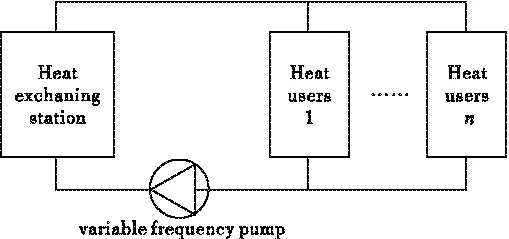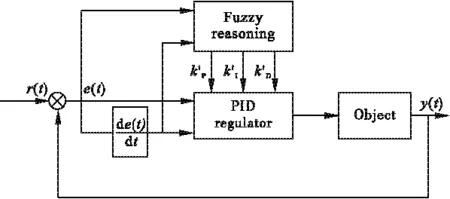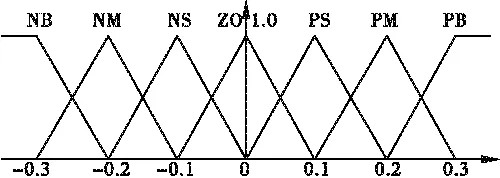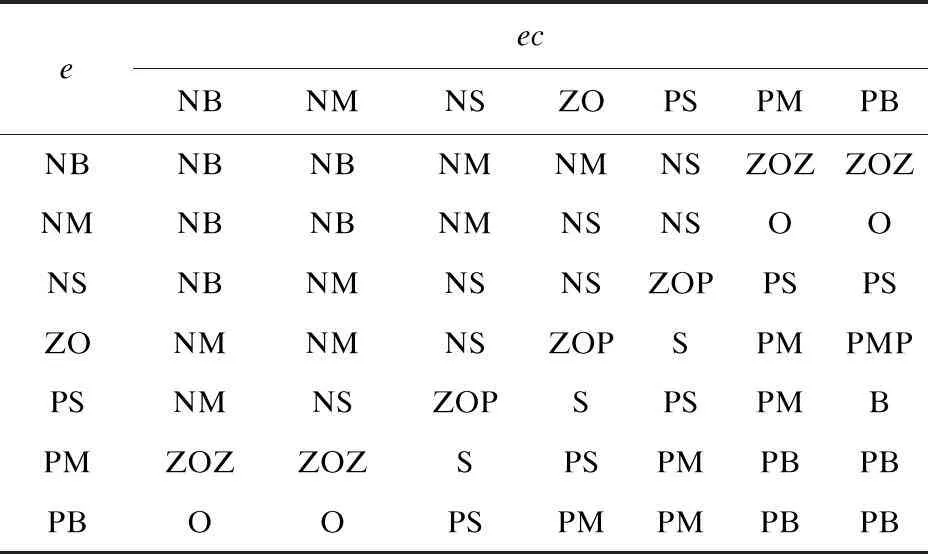The Application and Simulation of Fuzzy Adaptive PID in Household Heating Metering System
ZHAO Yawei,LIU Ying
(Shenyang Ligong University,Shenyang 110159,China)
The Application and Simulation of Fuzzy Adaptive PID in Household Heating Metering System
ZHAO Yawei,LIU Ying
(Shenyang Ligong University,Shenyang 110159,China)
Abstract:After heat is metered in each house unit,the heating system is regulated by variable flow.The temperature of the return water is controlled to regulate the flow to realize the temperature regulation.According to the characteristics of the temperature control with big inertia,pure time-delay and degeneration,a fuzzy adaptive PID controller is designed with the advantages of the fuzzy control and PID algorithm,and the simulation model is established according to the characteristics of heating metering system.Simulation results show that the fuzzy adaptive PID controller proposed has small overshoot,short oscillation cycle,high precision and strong anti-jamming capability in comparison with conventional PID controller,which could meet the requirement of the dynamic and steady-state performance of the heating process.
Key words:fuzzy adaptive PID;household metering heating;temperature control
CLC number: TP273Document code: A
As the tension of energy resources in the world,saving energy and protecting the environment are not ignored.In the north towns of our country,the consumption of heating energy is 40% of the total energy consumption of urban construction,which is the largest part of the building energy consumption.In our country,average energy consumption to heat each square is each year which is converted to standard coal,and it is 1~1.5 times compared with that of buildings in the same latitude in Nordic and other countries.The rate of the energy utilization is not high and the potential of saving energy is tremendous.After the heat is metered in each house unit,the users could regulate the flow according to their need,then the indoor heating system becomes a variable flow system[1]which controls the temperature of the return water to regulate the flow.The temperature control of the heat exchanging station is big inertia、pure time-delay and degeneration and it is difficult to establish accurate mathematical model[2].If the control is inappropriate and response time is too long because of being adjusted quite slowly,the system requirements can’t be satisfied.And if the adjusting is quite fast,the temperature overshoot easily and the shocks[3]could be caused.So it is difficult to get satisfactory control effect for the traditional PID controller.Fuzzy control is a kind of intelligent control method with the characteristics of good adaptability to control and smooth control process.It does not need to establish mathematical model for the complicated system with the nonlinear and large delay.It has the abilities of strong adaptive and anti-interference and has not the abilities of eliminating static error.So the PID control and fuzzy control are combined to constitute a fuzzy PID control with their advantages to improve the control quality of the system,which not only has the fuzzy control’s characteristics of better dynamic response and small overshoot and strong adaptive capacity and anti-jamming capability and so on,but also has the PID control’s advantages of high control precision and eliminating static error.
1 THE STRUCTURE OF HOUSEHOLD HEATING METERING SYSTEM
The heat exchanging station is the central link of central heating system and its operation has direct influence on the heating quality.The structure diagram of the heating metering system is shown in figure 1.In the heating metering system,the user installs the heat meter,so the user could regulate the indoor temperature according to the need.And the heating system changes the water flow to realize the temperature control.The system controls the input voltage of the frequency converter to change the speed of the water circulating pump,which could change the circulating water flow of the system in order to realize the stability control of the new system.So the heating metering system is a dynamic system.The traditional PID control could not set PID parameters on real time,which must make the system unstable,so the fuzzy adaptive PID is used to realize the stability control of heating system in the paper.

Figure 1 Structure diagram of the heating metering system
2 DESIGN OF THE FUZZY ADAPTIVE PID CONTROLLER
2.1 The structure of the fuzzy adaptive PID
The fuzzy adaptive PID controller takes erroreand error changeecas inputs which could self-adjust parameters of PID in different moment.The fuzzy adaptive PID controller is established by that the fuzzy control rules modify the parameters of PID on line[4].The structure is shown in figure 2.

Figure 2 Structure diagram of the fuzzy adaptive
The functions and the relationships of three parameters in different time should be considered when the PID parameters are set.The fuzzy self-adjusting PID calculates error e and error change ec of the current system based on the PID algorithm and makes fuzzy reasoning using the fuzzy rules and adjusts the parameters by inquiring the fuzzy matrix table.Parameter correction formula is the following:
(1)
(2)
(3)

2.2 The application of the fuzzy adaptive PID in heating metering system
The language variables of input variableseandecareEandEC,and the language variables of output variablesΔKP,ΔKI,ΔKDareKP,KI,KD,and fuzzy subset of these language variables is defined as { NB,NM,NS,ZO,PS,PM,PB }.The above defined are shown in table 1.

Table 1 Input and output variable fuzzeiication data sheet
The inputs of the fuzzy controller are conversed through the quantitative factor,and the outputs are conversed through the scale factor.The conversion formula of the quantization factor and the scale factor is the following:
(4)
The membership functions are used triangular membership functions and are shown in figure 3,4,5,6.

Figure 3 Membership functions of e and ec

Figure 4 Membership function of ΔKP

Figure 5 Membership function of ΔKI

Figure 6 Membership function of ΔKD
The fuzzy control rules table ofΔKP,ΔKP,ΔKI,ΔKDis shown in table 2,3,4.

Table 2 Fuzzy control rules table of ΔKP

Table 3 Fuzzy control rules table of ΔKI
3 SIMULATION COMPARISON BETWEEN PID AND FUZZY ADAPTIVE PID
The control structure of heating metering system is shown in figure 7.

Figure 7 Structure diagram of heating system
Based on the characteristics of the heating system,the system is approximately equivalent to be as a first-order inertia link and a lag link,and the frequency converter and circulating pump are approximately equivalent to be as a first-order inertia link,and the time constant and the delay time of the other controlling and testing links in the system could be ignored compared with those of the heating system[5].So the mathematical model of the heating system could be regarded as two series inertial links with pure delay.The approximate model of the system is the following:
(5)
The PID simulation structure of the system is shown in figure 8.

Figure 8 PID simulation structure of the system
The simulation tool is the Simulink toolbox of Matlab.The PID parameters of the system are set by using Z-N formula[6].Firstly,KIandKDare zero respecotively,namelyKI=0,KD=0.ThenKPis increased until the system begins to oscillate.The value ofKmis recorded.The adjusting formula is the following:
KP=0.6Km
(6)
(7)
(8)
After the parameters are adjusted,the results are that:KP=0.15,KI=0.0015,KD=2.Based on the figure 9 named fuzzy adaptive PID simulation structure of the system,the outputs of the fuzzy adaptive controller areKP,KI,KDand their adjusted values areΔKP,ΔKI,ΔKD,and then the outputs add their adjusted values to get the PID control parameters which change with the system in order to realize on-line setting of the PID control parameters to improve the control quality of the system.
In the heating system,the flow of the recycling water or the temperature of the supplying water are changeable which could lead the temperature of the returning water to change,and the temperature of the returning water could reflect the level of demand for heat of the system,so it is scientific to take the temperature of the returning water as setting value,which regulars the flow of the system based on measuring the temperature of the returning water in order to realize to regulate the heat of the whole system.The designed temperature of the returning water in the system changes with the outdoor temperature.When the outdoor temperature is-25℃,the temperature of the returning water is 60℃ as the designed value of the system.The simulation results of the fuzzy adaptive PID and the traditional PID control is shown in figure 10.

Figure 9 Fuzzy adaptive PID simulation structure of the system

Figure 10 The comparison between PID control and
Based on the figure10,in the condition of that the changing speed of the output of the system is not influenced,the controlled overshoot is 13%by PID and the system is steady after t is 50s.The fuzzy adaptive PID realizes the non-overshoot control with short adjusting time and it is basically steady when the operation lasts about 33s.The result is that the fuzzy adaptive PID could realize the control of the heating system with good control quality.
4 CONCLUSION
The heating system is nonlinear,time-varying and without accurate mathematical model.This paper adopts the fuzzy adaptive PID to make the control parameters of the control system response timely according to that the system changes to improve the control quality of the control system.
This paper takes the heating metering system as the researching object,adopts the fuzzy adaptive PID,takes the temperature of the returning water as control parameters,takes the flow as the controlled object and simulates the control.The simulation result shows that the fuzzy adaptive PID control has fast response time and small overshoot to improve the robustness of the heating system,which is a certain theoretical foundation of the actual application of the new system.
REFERENCES:
[1]Chunxian SHAN,Wanjia CHEN,Jie PENG.Design and Simulation of Temperature Control System of Heating Exchanging Station Based on Fuzzy PID Control[J].Instrument technology and sensor,2009,(9):79-82.
[2]Chengying QI,Junru GAO,Lide FANG.New intelligent heat metering control system[J].Journal of HV&AC,2004,34(10):103-105.
[3]Yinghe ZHU,Lingyun XUE,Wei HUANG.Design of Fuzzy PID Controller Based on Self-organizing Adjustment Factors[J].Journal of system simulation,2011,23(12):2732-2737.
[4]Wei Huang,Yinghe Zhu,Lingyun Xue.Research of a Self-organizing Fuzzy PID Controller in LED die Source-measure System[C].jinan,8th World Congress on Intelligent Control and Automation(WCICA),2010:2542-2547.
[5]Ruilan WANG.frequency control constant pressure water supply system based on Fuzzy-PID[D].Jinan,Shandong university,2006.
[6]Jinkun LIU.Advanced PID control MATLAB simulation[M].Beijing:Publishing house of electronics industry,2004.
(责任编辑:马金发)
Received date: 2013-12-24
Biography: LEI Ming(1975—),female,associate professor,Research direction:information and computing science.
Article ID: 1003-1251(2015)01-0087-08

